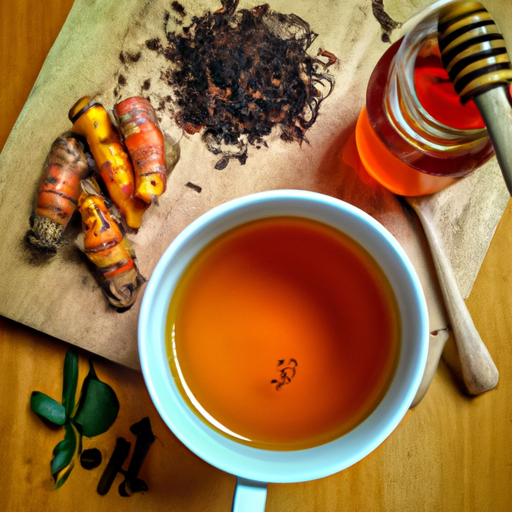I’m totally enamored with turmeric tea! It’s not just tasty, but also brimming with health advantages.
Turmeric has been used for centuries in traditional Ayurvedic medicine to treat a variety of ailments, from inflammation and digestive issues to skin problems and respiratory illnesses. The active ingredient in turmeric, curcumin, has powerful anti-inflammatory and antioxidant properties that can help reduce the risk of chronic diseases like cancer and Alzheimer’s.
If you’re looking for a natural way to boost your health and wellness, making turmeric tea from fresh root is an excellent place to start. It’s easy to prepare at home with just a few simple ingredients, and it tastes great too!
In this article, I’ll walk you through step-by-step how to make turmeric tea from fresh root so that you can experience all of its amazing health benefits for yourself. So grab your favorite mug and let’s get started!
Key Takeaways
- Turmeric tea contains curcumin with anti-inflammatory and antioxidant properties and can reduce the risk of chronic diseases like cancer and Alzheimer’s.
- It can be easily made at home from fresh turmeric root with filtered or purified water and optional add-ins like ginger, cinnamon, cardamom, and black pepper.
- The tea-to-water ratio is 1 tablespoon turmeric per cup boiling water and sweetener options include honey or maple syrup.
- Turmeric tea can be enjoyed daily as part of a routine for overall well-being and aids in digestion and immunity support.
Health Benefits of Turmeric Tea
Turmeric tea’s got a lot of health benefits, like reducing inflammation and boosting your immune system. For those who are looking to incorporate turmeric into their diet, turmeric tea recipes are an easy and delicious way to do so.
Turmeric is known for its strong anti-inflammatory properties, making it a great addition to any wellness routine. Not only does turmeric have anti-inflammatory effects, but it also contains antioxidants that help protect against free radicals in the body. These antioxidants can help prevent cell damage and lower the risk of chronic diseases such as cancer and heart disease.
Additionally, some studies have shown that drinking turmeric tea may improve brain function and reduce the risk of Alzheimer’s disease. Overall, incorporating turmeric into your diet through recipes such as turmeric tea can provide numerous health benefits.
From reducing inflammation to protecting against chronic diseases, adding this powerful spice to your routine is an easy way to support overall wellness. Now let’s dive into the ingredients needed for making fresh turmeric tea!
Ingredients Needed
I love making turmeric tea from fresh root because it’s easy and delicious.
All you need is some fresh turmeric root, water, and optional add-ins like honey or lemon.
In this discussion, we’ll explore these key ingredients and how they come together to create a tasty and healthy beverage.
Fresh Turmeric Root
Using the golden spice’s fresh version adds a flavorful twist to your tea-making process. Fresh turmeric root can be found in most grocery stores and is easy to use in cooking techniques such as grating, slicing or chopping.
Not only does it add a unique taste to your tea, but it also provides numerous health benefits. Curcumin, the active ingredient in turmeric, has anti-inflammatory properties that can aid with arthritis pain and other inflammatory conditions. Aside from its anti-inflammatory properties, turmeric has been shown to have antioxidant effects as well.
Adding fresh turmeric root into your tea can help boost your immune system and prevent chronic diseases such as cancer and heart disease. With all these natural health benefits packed into one spice, why not give it a try?
Now onto the next step – water!
Water
Now let’s add some H2O to this mix and get ready for a soothing sip. The quality of water used when making turmeric tea is crucial in bringing out the full flavor and health benefits of fresh turmeric root.
It’s best to use filtered or purified water, as tap water may contain impurities that can affect the taste and quality of your tea. When brewing turmeric tea, it’s important to consider the temperature and duration of the steeping process.
Boiling water can destroy some of the beneficial compounds found in turmeric, so it’s recommended to heat the water until it reaches a gentle simmer before adding in the grated or sliced turmeric root. Allow it to steep for 10-15 minutes, depending on how strong you want your tea to be.
Keeping these factors in mind will ensure that you get a flavorful cup of turmeric tea with maximum health benefits. Now onto optional add-ins for an extra boost!
Optional Add-Ins
You can’t resist adding some extra zing and oomph to your turmeric tea with these optional add-ins. Spice combinations like ginger, cinnamon, cardamom, and black pepper can enhance the flavor profile of your turmeric tea while providing additional health benefits.
Ginger is known for its anti-inflammatory properties and can aid in digestion. Cinnamon has antioxidant properties and may help lower blood sugar levels. Cardamom blends well with turmeric tea and provides a sweet aroma. This spice has been used in traditional medicine to treat digestive issues like bloating and constipation.
Lastly, adding a pinch of black pepper to your turmeric tea can increase the bioavailability of curcumin – the active ingredient in turmeric responsible for its many health benefits.
Now that we’ve covered optional add-ins, it’s time to move on to preparing the turmeric root.
Preparing the Turmeric Root
First, grab a fresh turmeric root and peel off the skin with a vegetable peeler or knife. It’s important to clean the turmeric root well before using it to make tea. You can rinse it under cold water and scrub it gently with a brush to remove any dirt or debris. Once cleaned, slice the turmeric root into thin pieces.
To create an image in your mind of how to properly prepare the turmeric root for tea-making, here is a table:
| Turmeric Root | Preparing Method |
|---|---|
| Fresh Turmeric Root | Peel off the skin with a vegetable peeler or knife |
| Dirty Turmeric Root | Rinse under cold water and scrub gently with a brush |
| Slicing | Cut into thin pieces |
Slicing the turmeric root will help release more of its flavor and benefits into your tea. Now that we have prepared our turmeric root, let’s move on to boiling the water for our tea.
Boiling the Water
Get ready to experience a soothing sensation as the water comes to a boil in preparation for your turmeric-infused beverage. The first step is to fill up a kettle or pot with fresh, cold water. It’s important to use only fresh water, as this’ll ensure that the tea has a clean and pure taste.
Next, place the kettle on the stove and turn up the heat to high. As you wait for the water temperature to rise, take this time to prepare your fresh turmeric root. Rinse it thoroughly under running water and then peel off any skin using a vegetable peeler or knife. Once peeled, chop it into small pieces or grate it using a fine grater.
While waiting for the water to boil, consider these factors that can affect your tea’s taste:
- Water temperature: Boiling hot water will extract more flavor from your ingredients than cooler water.
- Steeping time: Letting the tea steep for too long can result in an overly strong brew while steeping too little may make it bland.
- Tea-to-water ratio: A good rule of thumb is 1 tablespoon of grated turmeric per cup (8 ounces) of boiling water.
- Sweetener options: Honey or maple syrup are great natural sweeteners that complement turmeric well.
Once the water reaches its boiling point, turn off the heat and let it sit for about one minute before adding in your chopped or grated turmeric root. This’ll prevent scalding and allow you to maintain optimal control over your brewing process.
Adding the Turmeric Root to the Water
As the water sits for a minute, it’s time to infuse your brew with the vibrant and aromatic turmeric. Turmeric root benefits are numerous, from its anti-inflammatory properties to its ability to boost immune function. Using fresh turmeric root adds an extra layer of flavor and wellness benefits to your tea.
To add the turmeric root to the water, start by washing and peeling a small piece of fresh turmeric root. You can grate or chop it into small pieces before adding it to the water, or simply drop in a whole piece. For alternative brewing methods, you can also use powdered turmeric or even turmeric tea bags.
Once you’ve added the turmeric root (or powder/tea bags), let it steep in the hot water for about 5-10 minutes. This allows time for all of those beneficial compounds in the turmeric to dissolve into your tea.
Next up is simmering the tea, which will further enhance both flavor and health benefits.
Simmering the Tea
Now it’s time to bring out the rich flavors and health benefits of your turmeric-infused water by gently simmering it over low heat, allowing the ingredients to meld together perfectly.
Simmering is a crucial step in making turmeric tea from fresh root because it helps release the full potential of this powerful ingredient. By boiling the mixture too vigorously, you risk losing some of its beneficial compounds.
Here are two different simmering techniques that you can try:
-
Traditional Simmering: This method involves letting your turmeric tea come to a boil and then reducing the heat to a gentle simmer for around 10 minutes. This technique will give you a strong and robust tea that is perfect for those who love an intense flavor.
-
Gentle Simmering: If you prefer a milder flavor, try using gentle simmering instead. Simply let your water and turmeric root mixture come to a boil and then immediately reduce the heat to very low. Let it gently simmer for 5-7 minutes before turning off the heat altogether.
Now that your turmeric tea has been simmered to perfection, it’s time to move on to straining it through a fine mesh sieve or cheesecloth.
With just one more step, you’ll be able to enjoy all of its delicious flavors and amazing health benefits in every sip!
Straining the Tea
After simmering the turmeric-infused water, the next step is to strain out any remaining bits of root using a fine mesh sieve or cheesecloth, revealing a smooth and flavorful beverage that will leave your taste buds begging for more. Straining techniques can vary depending on personal preference and available tools. If using a fine mesh sieve, pour the tea through the sieve into your cup or teapot. If using cheesecloth, first place it over a large bowl or pitcher and carefully pour the tea through it.
When straining with cheesecloth, keep in mind that it may take longer for the tea to pass through due to its tighter weave. However, this method tends to produce a clearer liquid without any sediment at the bottom of your cup. Additionally, after straining you can save any leftover turmeric pulp to use in alternative ways such as adding it to smoothies or incorporating it into cooking recipes.
With our freshly strained turmeric tea ready to go, we can now move onto adding optional add-ins such as honey or lemon juice for added flavor and health benefits.
Adding Optional Add-Ins
To enhance the flavor and health benefits of our strained turmeric infusion, we can add in a dollop of honey or a squeeze of fresh lemon juice. These optional add-ins not only offer flavor variations but also provide additional health benefits.
Here are some recommended sweeteners to try:
- Raw honey – rich in antioxidants and has antibacterial properties
- Stevia – zero calorie sweetener that doesn’t affect blood sugar levels
- Maple syrup – contains minerals like zinc, manganese, and calcium
Adding any one of these options will give your turmeric tea a touch of sweetness without compromising its medicinal properties.
Once you’ve added your preferred sweetener, stir well to ensure it’s fully incorporated into the turmeric tea. You can also experiment with other flavors such as cinnamon or ginger for an added kick. Remember to always use fresh ingredients for maximum flavor and health benefits.
Now that our turmeric tea is complete with optional add-ins, it’s time to learn how to properly store and reheat it for future consumption without losing its potency.
Storing and Reheating Turmeric Tea
To keep your turmeric infusion fresh and potent, you’ll want to store it in an airtight container in the refrigerator. This ensures that your tea stays free from bacteria and lasts for several days.
You can also freeze turmeric tea if you have leftovers that are more than a couple of days old.
When reheating turmeric tea, make sure not to boil it as this could destroy some of the beneficial compounds present in the spice. Instead, simply heat it up on low or medium heat until warm. You can also add milk or honey to taste when reheating your tea for added flavor.
Turmeric tea storage tips are essential if you want to enjoy its numerous health benefits for longer periods. By following these guidelines, you can ensure that your turmeric infusion remains fresh and flavorful every time you drink it.
Now let’s move on to enjoying your fresh turmeric tea!
Enjoying Your Fresh Turmeric Tea!
Indulge in the heavenly taste of your newly brewed turmeric elixir and feel your body rejuvenate with every sip! But before you take that first sip, take a moment to savor the aroma. The scent of fresh turmeric root is invigorating, and it’s a sure sign that you’ve brewed your tea correctly.
When enjoying your fresh turmeric tea, it’s important to remember the brewing process. The longer you steep the tea, the stronger it will be in both flavor and health benefits. However, don’t let it steep for too long or else it may become bitter. I recommend steeping for 10-15 minutes for optimal results.
As you savor your cup of turmeric tea, take note of how it makes you feel. Turmeric has been known for its anti-inflammatory properties and can aid in digestion and immunity support. So not only does this beverage taste great but also has numerous health benefits!
Enjoy this natural elixir as part of your daily routine and watch as it helps improve your overall well-being.
Frequently Asked Questions
How much turmeric root should be used to make one cup of turmeric tea?
When making turmeric tea with fresh root, the amount needed for one cup can vary depending on personal preference. Generally, it’s recommended to use 1-2 teaspoons of grated or sliced turmeric root per cup of water. However, some people may prefer a stronger flavor and use more.
Consuming turmeric tea regularly has been linked to numerous health benefits, including reducing inflammation, improving brain function, and reducing the risk of chronic diseases such as heart disease and cancer. Additionally, turmeric contains antioxidants that help protect the body from damage caused by free radicals.
Incorporating turmeric into your daily routine through drinking tea is an easy way to reap these benefits and promote overall wellness.
Can turmeric tea be made with ground turmeric instead of fresh root?
Yes, turmeric tea can be made with ground turmeric instead of fresh root. However, using fresh turmeric root in your tea has its own set of benefits. Fresh turmeric root has a stronger flavor and aroma compared to powdered or ground turmeric, which adds depth and complexity to the taste of your tea.
Additionally, fresh turmeric contains higher levels of curcumin, the active ingredient responsible for its numerous health benefits such as reducing inflammation and improving brain function. While using ground turmeric may be more convenient, incorporating fresh roots into your diet can provide added nutritional value that is hard to match with just the powder form.
Can honey be added to turmeric tea for sweetness?
Oh, of course you can add honey to turmeric tea for sweetness! Because why enjoy the natural health benefits and earthy flavor of turmeric when you can just drown it in sugar?
But if you’re looking for honey alternatives or ways to enhance the flavor without overloading on sweeteners, consider adding spices like cinnamon, ginger, or cardamom. These’ll not only provide a delicious taste but also offer additional health benefits.
And if you really wanna get creative, try experimenting with different herbs like mint or basil. It’s all about finding what works best for your taste buds and wellness goals.
Can turmeric tea be consumed cold or does it need to be served hot?
Turmeric tea can be enjoyed both hot and cold, depending on your preference. While traditionally served hot, some people prefer to consume it chilled as a refreshing summer beverage. Either way, turmeric tea is packed with health benefits that make it a great addition to any diet.
It contains anti-inflammatory properties that can help reduce joint pain and improve digestion. Additionally, turmeric has been shown to boost the immune system and lower the risk of chronic diseases such as cancer and Alzheimer’s. So whether you’re sipping on a warm cup or enjoying an iced glass, make sure to reap the many benefits of this delicious and nutritious drink!
How often should turmeric tea be consumed to experience its health benefits?
Turmeric tea is a warm and soothing drink that has numerous health benefits. It’s like a gentle hug for your insides. When it comes to frequency benefits and dosage guidelines, the key is to listen to your body.
If you’re just starting out, begin with one cup per day and gradually increase as you see fit. Some people find that drinking turmeric tea every day works well for them, while others prefer to consume it a few times per week. Ultimately, it depends on what feels right for you and your lifestyle.
Remember to take note of any changes in how you feel after consuming turmeric tea – if you experience any discomfort or adverse effects, then consider reducing the frequency or dosage accordingly.
Conclusion
Well folks, I hope you enjoyed this little tutorial on how to make turmeric tea from fresh root. Now, I know what you’re thinking: ‘Wow, that sounds like a lot of work just for a cup of tea!’
But let me tell you, it’s worth it. Not only is turmeric tea packed with health benefits like reducing inflammation and boosting your immune system, but making it from scratch can be a therapeutic and grounding experience.
So next time you’re feeling stressed or under the weather, take some time to prepare yourself a warm cup of turmeric tea. Your body (and mind) will thank you.










